




From Laguna de Medina go over the A381 and take the A3202 past the cement works towards El Portal (make sure you ignore the service roads at either end of the bridge!). Go under the E5 and continue along this minor road until you reach a crossroads. Turn left here onto the CA 3113 which skirts a huge area of marshes and salinas. Drive past the rubbish tip and the track to the salinas is a little further on after a cuple of bends. It's about 9km from Laguna de Medina and should take c15 minutes to reach the salinas. I've had no further luck with eagle owl here, but there are huge numbers of Cattle Egrets and White Storks, and in season Black Kites) around the tip. The road beyond the tip (swing left by the gates at the top of the hill) offers fantastic views over the lowlands here.







 RSS Feed
RSS Feed
